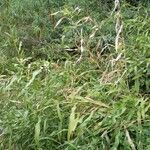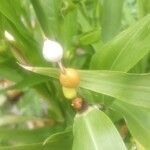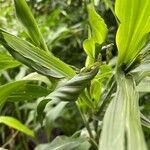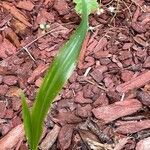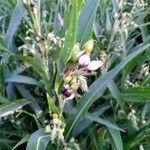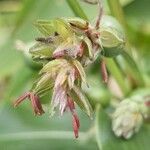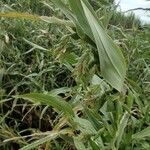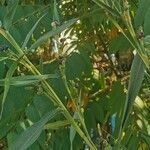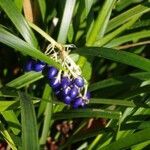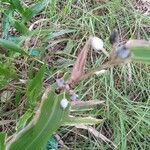A millet grass. It is a loosely tufted, tall, annual grass. It grows up to 1-2 m high with long slender leaves. The stems have a soft, white, centre inside. The leaves can be 60 cm long and 3-5 cm wide. The sheath of the leaf around the stem, is short. The flower stalk is long and arching. Male and female flowers are in separate spikes on the flowering stalk. The female flowers have a hard covering which changes from green to black to white, as it ripens. Male flowers are small and on top. The seed is like a bead and used for necklaces. They are 1.5 cm long. The seeds are green when young, and turn to pearly grey or purple when mature.
Annual, 0.9-1.2 m high. Leaf blade 100-500 x 2-7 mm. Inflorescence a leafy false panicle, branches each subtended by a smooth hard, whitish to ivory-like bead or cupule enclosing female spikelet; male spikelet on a tassel exserted from bead. Spikelets unisexual; female spikelet up to 5 mm long; male spikelet 7-10 mm long; anther of male spikelet up to 4.5 mm long. Flowering time Aug.-Apr.
Annual or ?perennial 900-1200 mm high. Leaf blade 100-500 x 2-7 mm. Inflorescence branches each subtended by a smooth hard, whitish to ivory-like bead or cupule enclosing the female spikelet; male spikelet is on a tassel exserted from the bead. Spikelets unisexual; female spikelet up to 5 mm long; male spikelet 7-10 mm long; anther of male spikelet up to 4.5 mm long.
Culms freely branching, 1 m. or more high; blades as much as 50 cm. long, the upper ones commonly 10-20 cm. long, 2-3.5 cm. wide, rounded or cordate-clasping at the base; staminate part of the inflorescence 2-4 cm. long, the spikelets 8-10 mm. long; beads or sheathing bracts about 1 cm. long, smooth and shining.
Annual; 0.9-1.2 m high. Leaf blades 100-500 x 2-7 mm. Flowers: in a complex; leafy; false panicle; inflorescence branches each subtended by a smooth; ivory-like bead or cupule enclosing female spikelets; male spikelets on a tassel exserted from bead; spikelets 7-10 mm long; unisexual.
Coarse annual; culms 1–3 m. high.. Leaf-blades linear-lanceolate, 10–45 cm. long, 2–7 cm. wide, cordate at the base.. Cupule 5–15 mm. long, typically globose-ovoid, bony, shining, white or bluish.. Male raceme 3–5 cm. long, the spikelets 7–8 mm. long.. Fig. 205.
Annual, up 1.2 m high. Leaf blades 100-500 mm long, 2-7 mm wide. Spikelets 7-10 mm long (unisexual). Inflorescence involucre hard, whitish and beadlike.
“job’s Tears”
